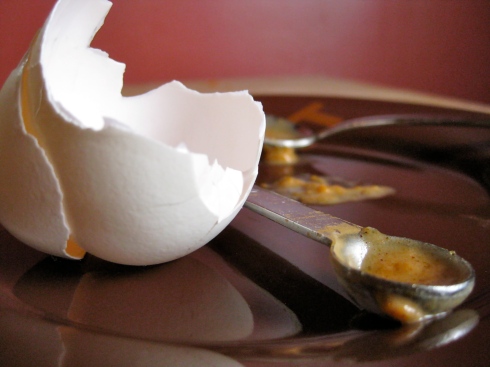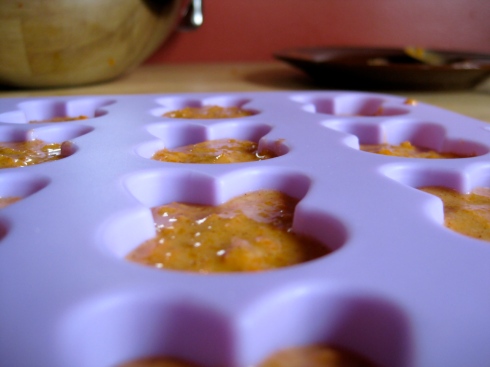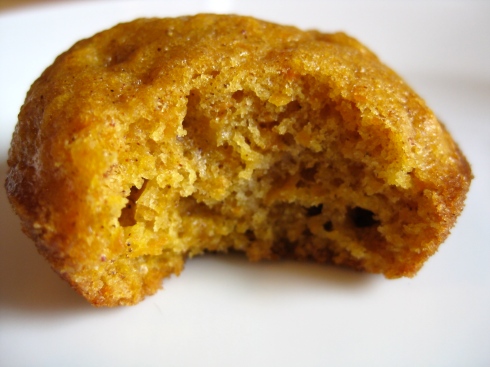Sometimes I forget that just because someone likes something, it does not necessarily mean that that person wants to eat that thing. Allow me to explain. If one was to walk into our house, what one would discover almost immediately is that a certain member of the household is very, very interested in bunny rabbits. There are bunny rabbit books, bunny rabbit toys, bunny rabbit decorations, and occasionally, bunny rabbits in custom made articles of clothing.
It was in the culinary interest of this bunny rabbit interest that I made the decision to purchase a 24 cavity silicone bunny rabbit baking mold. Call it a moment of temporary insanity, or perhaps just an instance of intensely debated coercion, but the fact remains that I am now the proud owner of a baking mold in the shape of a small child’s most favorite animal.
Which is where my initial point comes into play. After bringing home the bunny mold and wondering our loud what I might be able to do with it, it was brought to my attention (by the same party who lobbied so very heavily for the item’s purchase) that, no, it would not be all right to eat something shaped like a bunny, because, hello? That would mean that you were eating a bunny. It was a thought that, though riddled with illogical assumptions, actually made a tiny bit of sense to me (when thought about from the perspective of a preschooler, that is, which means that most of your thinking will end up being sort of nonlinear and riddled with images from Richard Scarry books and The Country Bunny).
My only course of action at this point, if I wanted to get any use out of that pan, was to change the direction of the train of thought that equated bunny-shaped foods with bunny-cide. In a moment of near genius (in the low-bar world of bargaining with a small child), I proposed that perhaps if a food made of something that bunnies like to eat themselves was prepared in the bunny pan, maybe that would, in effect, bring one closer to eating like a bunny rather than eating an actual bunny.
My some miracle, my tactic worked. Thirty minutes later, my son and I were sitting down to feast upon some of the most sweet and savory muffins we’d ever had the pleasure of meeting. My rescue was courtesy of Rose Levy Beranbaum, who not only makes the brilliant suggestion of using turbinado sugar in the recipe in lieu of regular sugar (which has the effect of taking the sweetness of the muffin to a place that is more caramelized, and less distractingly sweet), but also recommends that the baked item (which she bakes as a 9” x 5” loaf of bread) sit for 24 hours in order for the moisture to properly distribute throughout the entirety of the loaf.
Not one to argue with Ms. Beranbaum, but definitely interested in eating the carrot muffins before the dawn of a new day, I exercised my newly flexed muscles of rationalization and came to the conclusion that, baked as tiny little muffins, these carrot delights would be, at most, a mere 1 inch thick and 1.5 inches tall. Using math skills only previously displayed by recipients of the Fields Medal, I thus determined that the muffins would only have to sit for a maximum of five minutes before they could be fully enjoyed at the height of their deliciousness. A logical judgment in mathematics? Probably not. But an exercise in deliciousness? Definitely.
Carrot Muffins
Adapted from The Bread Bible, by Rose Levy Beranbaum
As previously mentioned, Beranbaum developed this recipe to be baked as a single loaf of bread. I modified the recipe to fill 24 bunny-shaped cups (with a small amount of batter leftover to make 6 mini muffins), which resulted in cutting the recipe in half. This left me with the unfortunate task of having to somehow halve 3 eggs, but I soon realized that by using 1 extra-large egg instead of using 1.5 large ones, a similar effect could be achieved. This is a long way of explaining why some of the measurements listed here seem a little peculiar.
Preheat oven to 350 degrees F. Place an oven shelf on the lower-middle level.
If using a bunny-shaped mold, very lightly grease the insides of the bunny cavities (silicone isn’t supposed to stick, but the nature of the bunny ear shapes makes for some serious sticking with these very moist muffins). There will be enough batter left over to make six mini muffins (lightly grease the mini muffin cups) or one smallish regular-sized muffin (use one paper muffin or cupcake liner). Alternately, you could just make 6 regular-sized muffins and call it good.
3/4 cup plus 2 teaspoons unbleached all-purpose flour
1 1/2 teaspoons baking powder
1/4 teaspoon baking soda
1/4 teaspoon salt
1 teaspoon cinnamon
1 extra-large egg
1/4 cup vegetable oil
1/2 cup sugar, preferably turbinado
1 3/4 cups finely grated carrots
In a medium bowl, whisk together the flour, baking powder, baking soda, salt, and cinnamon.
In a large bowl or a mixer bowl, using a wooden spoon or a hand-held or stand mixer (fitted with the paddle attachment) on low speed, mix together the egg, oil, and sugar for one minute or until blended. Add the flour mixture and continue stirring or beating on low speed just until incorporated, about 20 seconds. Add the carrots and continue stirring or beating for another 10 seconds or so.
If baking bunny-shaped muffins, using a small spoon (I used a 1/2 teaspoon measuring spoon), drop enough batter in each cavity to fill it 2/3 to 3/4 full. Utilize remaining batter as previously mentioned. If making 6 regular-sized muffins, evenly fill all 6 muffin cups.
Bake the muffins for 12-15 minutes if you are making mini and bunny shaped muffins. Bake regular-sized muffins for 20-25 minutes













These are moist and tasty – not too sweet with a nice toothsome texture. Thanks for the delicious recipes!